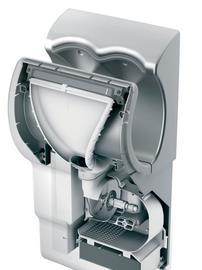An innovative dryer is helping a national power supplier to make its own contribution to energy saving by dispensing with hand towels
A move away from paper hand towels to electric blow-drying has saved EDF Energy about 90,000kWh and £33,000 a year.
EDF, which employs more than 12,000 people in the UK, is the largest electricity supplier for London and southern England. It is striving to reduce its own energy consumption through the development of renewable energy sources and to decrease its carbon emissions. Also, it hopes to cut the amount of waste it sends to landfill to zero by 2020.
The consumption of paper towels was an obvious area to investigate when trying to take action on all three fronts.
Previously EDF Energy used a combination of paper towels and warm-air hand-dryers in its washrooms. Staff tended to prefer the paper over the dryers, which created a large amount of waste paper that needed disposal.
EDF looked into different environmentally friendly options, and a decision was made to roll out 188 of the Dyson Airblade hand-dryers for a pilot project across eight company sites.
To calculate savings, the firm assumed that one box of paper towels contains 2700 individual towels, which meant that the eight EDF sites consumed just over 9.1 million towels annually – that’s 31 tonnes of paper.
It is important to remember that the environmental impact of paper towels does not cease when they are buried as rubbish. When in landfill, the cellulose content is broken down, producing carbon dioxide and also methane, which has a global warming potential 23 times that of CO2. If all the hand towels used by EDF Energy staff were broken down in landfill under ideal composition conditions, the total of greenhouse gases produced would be equivalent to 242 tonnes of CO2.
It was calculated that to produce the 9.1 million towels EDF uses annually requires 114,892kWh. To dry the same amount of hands, the Airblades use 24,250kWh, a saving of 90,642kWh and a reduction in CO2 emissions of about 49 tonnes.
It is important also to consider the manufacture and supply of the hand-dryers when making environmental comparisons.
The production and supply of the Air-blades is responsible for emitting about 84 tonnes of CO2. It will take about 21 months of Airblade use to recoup this before the unit moves into a reduction of carbon dioxide.
The Airblade operates by forcing unheated air through a 0.3mm gap, no thicker than an eyelash. This creates a sheet of air travelling at about 400mph, which users pass their hands through.
The speeding air acts like an invisible windscreen wiper, removing moisture from hands and leaving them dry in 10 seconds. The Airblade uses up to 80% less energy than other traditional warm-air hand-dryers, according to Dyson.
The manufacturer also claims that the Airblade is the first and only hand-dryer to be certified to meet the requirements of the NSF Protocol 335 for a hygienic hand- drying system. NSF International is the US-based not-for-profit consulting body on food, water and consumer goods, which reports to governments and international organisations.
Source
Building Sustainable Design






















No comments yet